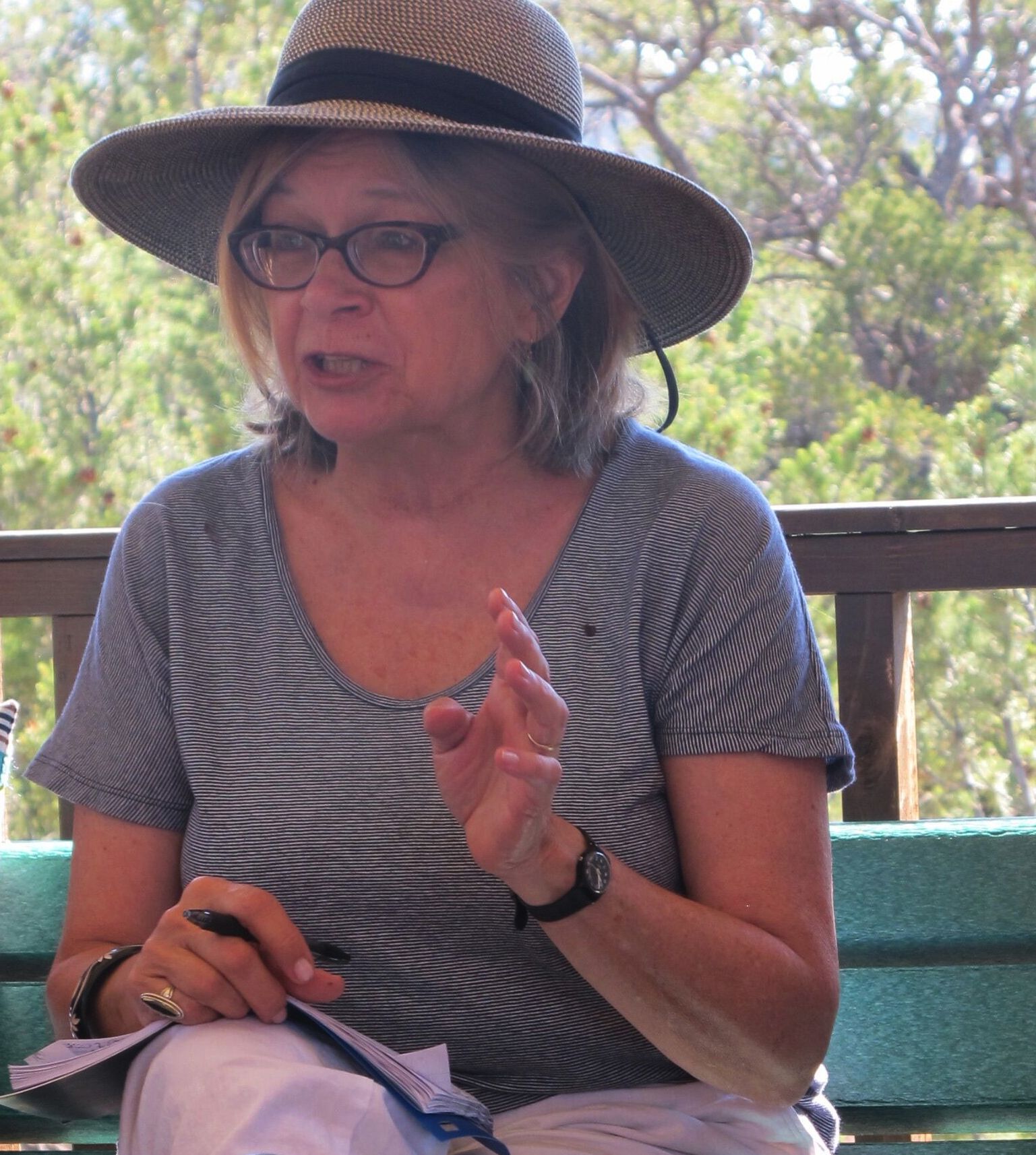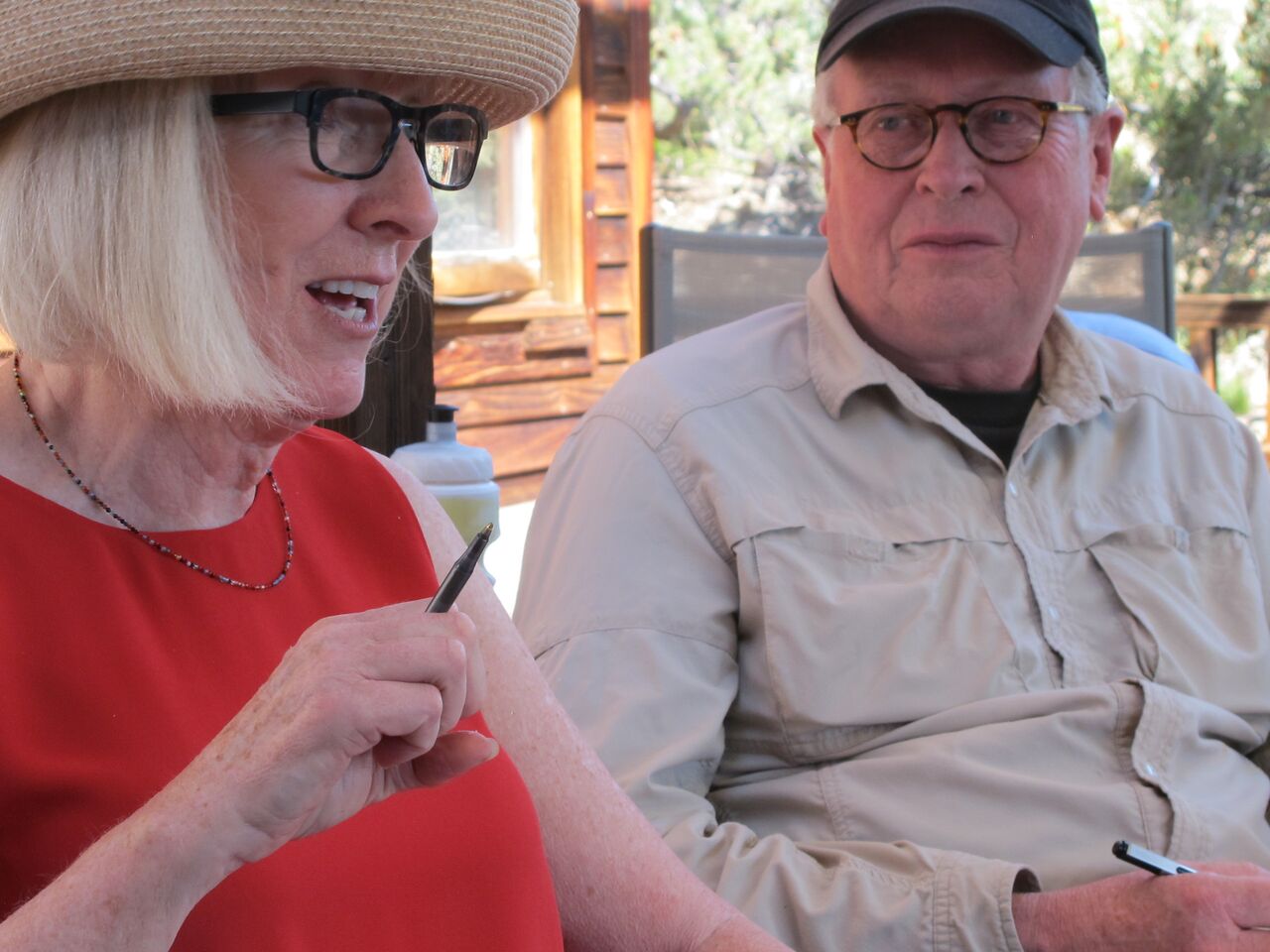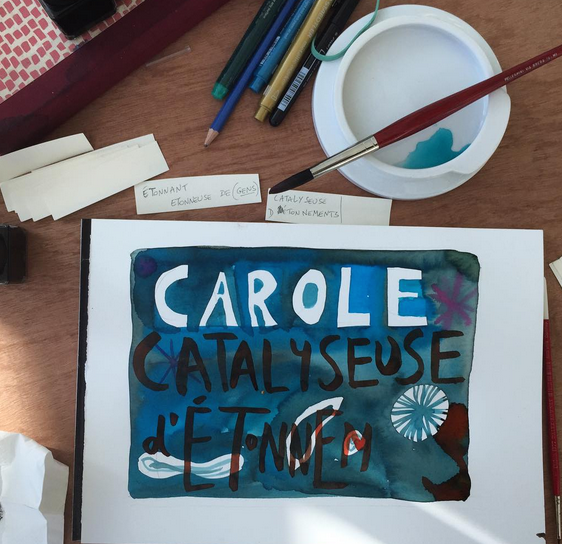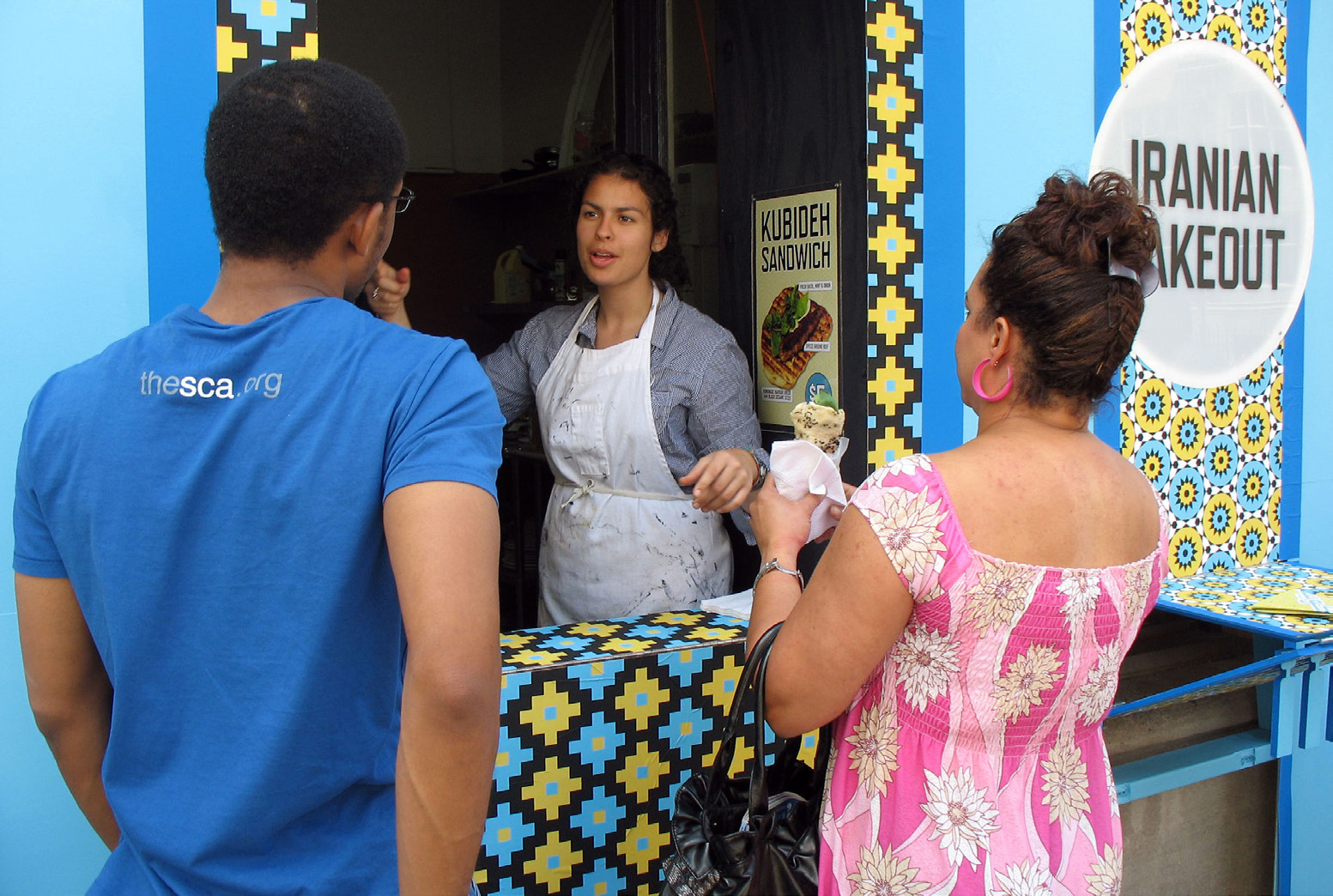
Susan Yelavich at HighGround, July 2016; Photo by Janet Abrams
Director and Associate Professor Susan Yelavich participates in the 20th annual HighGround colloquium. Read about her proposals for design and her reflections here:
This year at the 20th annual HighGround colloquium organized by designers Katherine and Michael McCoy at their studio/home in Colorado, I proposed a series of design moves (some strategic, some tactical) to shift social perceptions of people who have been alienated, mistreated, or ignored because of race, gender, immigration, or mental health issues—or any combination of the above that leads to ‘othering.’ I thought that it might be timely to share them here, given the upcoming US Presidential elections, and the vortex of issues around it from Black Lives Matter to the treatment of immigrants and refugees in this country and others around the world.

Katherine and Michael McCoy, hosts of HighGround. Photo credit: Janet Abrams.
These proposals operate on the principle that Jacques Rancière, in The Emancipated Spectator, calls ‘aesthetic rupture’: the opening up of possibilities (otherwise foreclosed by prejudice) by making those possibilities visible and available to the senses. He sites an anecdote to explain how this might work referring to an 1848 French socialist newspaper publication of this short paragraph about a joiner:
Believing himself at home, he loves the arrangement of a room, so long as he has not finished laying the floor. If the window opens out onto a garden or commands a view of a picturesque horizon, he stops his arms and glides in imagination toward the spacious view to enjoy it better than the [owners] of the neighbouring residences.
Here an aesthetic rupture produced the appropriation of the place of work (and exploitation) as the site of a free gaze. The simultaneity of the joiner’s laboring arms and his distracted gaze introduced a new configuration of the sensible. When the laborer’s capacity for aesthetic pleasure is recognized as it was here, the result is a change in perception of the ‘right’ relationship between what a body ‘can’ do and what it cannot. Thus inspired by Rancière, these are my ten proposals for ‘aesthetic ruptures’ for our times.
1. Find poetics in unexpected places. Identify and record sites of possibility in factories, offices, places of the labor, and unemployment offices. For example, consider Milanese designer Elisa Bertolotti’s “Alterjob” project. Elisa painted business cards for people out of work or dissatisfied with their jobs in a derelict manufacturing town in Belgium. Among the imaginative possibilities this project elicited, one man said: “I want to be a postman who only delivers good news.”

“Carole, Catalysuese,” (Carol, the Catalyst) Alterjob, Elisa Bertolotti
2. For those who feel politically disenfranchised: Design buses and trailers to travel to county fairs across the U.S. like mobile libraries. Set up portable picnic tables at each stop and foster conversation with food as Conflict Kitchen does in Pittsburgh. (This take-out restaurant serves the food of countries that the U.S is in conflict with but doesn’t dictate the direction of the conversations that occur toward one bias or another.)

Conflict Kitchen, Photo from Veronice Uribe’s 2016 Thesis
3. In response to race killings in this country: Set up Truth and Reconciliation forums (like the ones held in Ireland after the ‘troubles’ and in South Africa after apartheid) for police and citizens.
4. Re the migration crisis, identify opportunities and resources that afford pleasure and don’t just satisfy needs. (Here I’m inspired by an anecdote of journalist Slavenka Drakulić, who left her homeland in Croatia during the Balkan wars in the 1990s to stay with her sister in Paris. Her sister asked what she needed and was taken aback when Slavenka said “lipstick.” Why should lipstick or other small pleasures be denied to refugees? Why do we treat them like penitents?
5. Regarding sustainment: create a communications campaign for modest consumption. Make ‘making do’ a badge of honor. Think of stores as museums with changing exhibitions of things that can be enjoyed by looking as much as buying.
6. We have memorials for wars but not gun violence victims. I propose a new kind of tourist landmark signage. For example, one side of the sign commemorating the slaughter of grade school children and teachers could read:
20 miles to Sandy Hook, CT
Site of Dec. 14, 2012 Massacre
The other side would read:
Sandy Hook, once home to:
(list victims names here)
7. Post landmark signs about aging infrastructure. For example:
Visit the _____ Tunnel. Count the cracks in the walls.
or
Oldest bridge in town. Erected in 1920.
Score card: Repairs 10; Potholes 2; Shutdowns 4; Accidents 15.
Jobs ????
8. Design and advertise bullet-proof clothing for children and adults for protection against drive-by (and other) shootings. Engage outlets like Babys R Us in the campaign.
9. Subversively co-opt the success of negative campaigns—from Brexit to Trump. Create new pictograms for messages such as: No Rape, No Child Abuse, No Assault Rifles, No Domestic Violence, etc. Place them randomly in communities, not just at schools or government buildings.

Humor from MA DS 2016 graduates: Estefania Acosta, Laura Sanchez, Misha Volf
10. Don’t neglect satire. As the aliens told Woody Allen in his 1980 film Star Dust Memories, we need to “tell funnier jokes.” Inspired by Brexit, the parallel crisis across the pond, we should change that phrase, to ‘tweet funnier insults.’ These are just some that could serve as inspiration. (They were written in response to UK Justice Minister Michael Gove’s post-Brexit tweet: “We need to renegotiate a new relationship with the EU, based on free trade and friendly cooperation.”) Someone called Dookie Howser MD wrote:
So, some sort of union with Europe? Wonder where we could find one of those?
Someone else wrote:
THAT IS WHAT WE ALREADY HAD YOU ARSE-
CHEEKED BOLLOCK-WAGON!
And it gets better.
You boil-in- the-bag rent-a- clown.
You are one confused bag of mince.
You incompetent ventriloquist-dummy- faced spunktrumpet!
You reprehensible spam faced tool bag!
You back stabbing cockwomble!
You’re an absolute wankcrumpet!
You pie!
Dickweasel!
Somehow it seems a much healthier way of venting and the time honored way to keep from crying in a world in which a terrifying nationalism and ungenerous isolationism is on the rise—once again.

Ten Proposals for Tenuous Times
Susan Yelavich at HighGround, July 2016; Photo by Janet Abrams
Director and Associate Professor Susan Yelavich participates in the 20th annual HighGround colloquium. Read about her proposals for design and her reflections here:
This year at the 20th annual HighGround colloquium organized by designers Katherine and Michael McCoy at their studio/home in Colorado, I proposed a series of design moves (some strategic, some tactical) to shift social perceptions of people who have been alienated, mistreated, or ignored because of race, gender, immigration, or mental health issues—or any combination of the above that leads to ‘othering.’ I thought that it might be timely to share them here, given the upcoming US Presidential elections, and the vortex of issues around it from Black Lives Matter to the treatment of immigrants and refugees in this country and others around the world.
Katherine and Michael McCoy, hosts of HighGround. Photo credit: Janet Abrams.
These proposals operate on the principle that Jacques Rancière, in The Emancipated Spectator, calls ‘aesthetic rupture’: the opening up of possibilities (otherwise foreclosed by prejudice) by making those possibilities visible and available to the senses. He sites an anecdote to explain how this might work referring to an 1848 French socialist newspaper publication of this short paragraph about a joiner:
Here an aesthetic rupture produced the appropriation of the place of work (and exploitation) as the site of a free gaze. The simultaneity of the joiner’s laboring arms and his distracted gaze introduced a new configuration of the sensible. When the laborer’s capacity for aesthetic pleasure is recognized as it was here, the result is a change in perception of the ‘right’ relationship between what a body ‘can’ do and what it cannot. Thus inspired by Rancière, these are my ten proposals for ‘aesthetic ruptures’ for our times.
1. Find poetics in unexpected places. Identify and record sites of possibility in factories, offices, places of the labor, and unemployment offices. For example, consider Milanese designer Elisa Bertolotti’s “Alterjob” project. Elisa painted business cards for people out of work or dissatisfied with their jobs in a derelict manufacturing town in Belgium. Among the imaginative possibilities this project elicited, one man said: “I want to be a postman who only delivers good news.”
“Carole, Catalysuese,” (Carol, the Catalyst) Alterjob, Elisa Bertolotti
2. For those who feel politically disenfranchised: Design buses and trailers to travel to county fairs across the U.S. like mobile libraries. Set up portable picnic tables at each stop and foster conversation with food as Conflict Kitchen does in Pittsburgh. (This take-out restaurant serves the food of countries that the U.S is in conflict with but doesn’t dictate the direction of the conversations that occur toward one bias or another.)
Conflict Kitchen, Photo from Veronice Uribe’s 2016 Thesis
3. In response to race killings in this country: Set up Truth and Reconciliation forums (like the ones held in Ireland after the ‘troubles’ and in South Africa after apartheid) for police and citizens.
4. Re the migration crisis, identify opportunities and resources that afford pleasure and don’t just satisfy needs. (Here I’m inspired by an anecdote of journalist Slavenka Drakulić, who left her homeland in Croatia during the Balkan wars in the 1990s to stay with her sister in Paris. Her sister asked what she needed and was taken aback when Slavenka said “lipstick.” Why should lipstick or other small pleasures be denied to refugees? Why do we treat them like penitents?
5. Regarding sustainment: create a communications campaign for modest consumption. Make ‘making do’ a badge of honor. Think of stores as museums with changing exhibitions of things that can be enjoyed by looking as much as buying.
6. We have memorials for wars but not gun violence victims. I propose a new kind of tourist landmark signage. For example, one side of the sign commemorating the slaughter of grade school children and teachers could read:
The other side would read:
7. Post landmark signs about aging infrastructure. For example:
or
8. Design and advertise bullet-proof clothing for children and adults for protection against drive-by (and other) shootings. Engage outlets like Babys R Us in the campaign.
9. Subversively co-opt the success of negative campaigns—from Brexit to Trump. Create new pictograms for messages such as: No Rape, No Child Abuse, No Assault Rifles, No Domestic Violence, etc. Place them randomly in communities, not just at schools or government buildings.
Humor from MA DS 2016 graduates: Estefania Acosta, Laura Sanchez, Misha Volf
10. Don’t neglect satire. As the aliens told Woody Allen in his 1980 film Star Dust Memories, we need to “tell funnier jokes.” Inspired by Brexit, the parallel crisis across the pond, we should change that phrase, to ‘tweet funnier insults.’ These are just some that could serve as inspiration. (They were written in response to UK Justice Minister Michael Gove’s post-Brexit tweet: “We need to renegotiate a new relationship with the EU, based on free trade and friendly cooperation.”) Someone called Dookie Howser MD wrote:
Someone else wrote:
And it gets better.
Somehow it seems a much healthier way of venting and the time honored way to keep from crying in a world in which a terrifying nationalism and ungenerous isolationism is on the rise—once again.